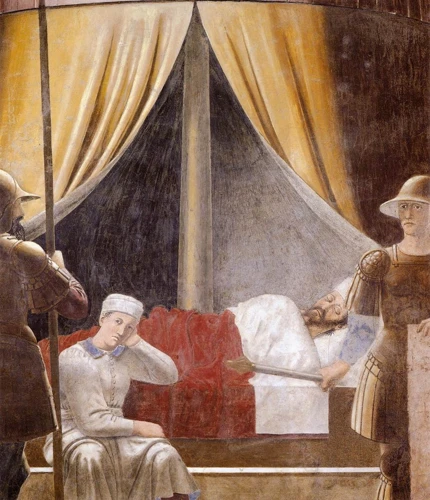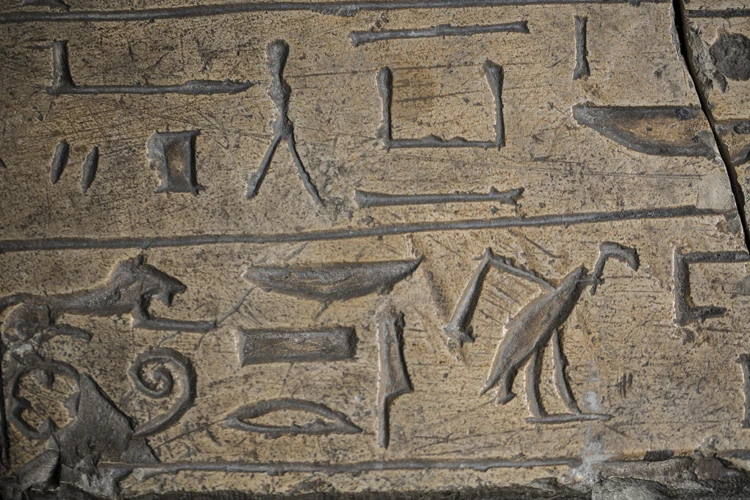Dreams have always fascinated humans, and their interpretations have been subjects of much curiosity and intrigue throughout history. From Ancient civilizations to modern times, people have attempted to decipher the meaning behind their nocturnal visions in hopes of gaining insight into their lives. However, the history of dream interpretation is a labyrinth of theories, myths, and cultural perspectives that remain puzzling to this day. In this article, we will take a step-by-step journey through the evolution of dream interpretation, exploring the fascinating world of ancient myths, the psychological perspectives of Freud and Jung, and the modern-day approaches of neuroscience and spirituality. Let us delve into the depths of this enigmatic subject and unravel the mysteries of dream interpretation.
The First Dream Interpreters

As long as humans have been conscious, they have been perplexed by dreams. Early civilizations attempted to make sense of them through storytelling, myths, and legends. However, it wasn’t until the emergence of more advanced societies that people began to document their dreams and create systems for interpreting them. The ancient Egyptians and Greeks are just a few of the early civilizations who provided us with glimpses into their beliefs and practices surrounding dreams. Let’s delve deeper into the history of these early dream interpreters.
Ancient Civilizations and their Myths
Many ancient civilizations believed that dreams were a window into the divine realm, and thus, they were greatly revered. Here are some examples of how different cultures viewed dreams:
1. Mesopotamian Civilization: The Mesopotamians believed that dreams were messages from the gods. They recorded their dreams in clay tablets, which were later interpreted by priests.
2. Hebrews: In Hebrew culture, dreams were often seen as prophetic visions from God. The Old Testament contains many references to dreams, including the story of Joseph and his interpretation of Pharaoh’s dream.
3. Chinese: Chinese philosophy revolves around the concept of “Qi,” which is the life force energy that flows through all things. They believed that dreams provided a way to see beyond the physical world and connect with the spiritual realm.
4. Native Americans: Native Americans believed that the dream world was a place where they could communicate with their ancestors and receive guidance from them. They often used dream catchers, which were believed to trap bad dreams and allow good dreams to pass through.
5. Aztecs: The Aztecs believed that dreams were a way of communicating with the gods. They often used the interpretation of dreams to make important decisions, such as before going to war.
All of these ancient civilizations had diverse beliefs about dreams that often had spiritual connotations.
The Egyptians and the Greeks
Ancient civilizations such as the Egyptians and the Greeks also had a significant role to play in the development of dream interpretation.
Egyptians: In ancient Egypt, dreams were considered a connection to the divine realm. They believed that the gods and goddesses would speak to people through their dreams. Egyptians even had “Dream Books”, which were considered sacred texts that contained interpretations of the symbols that appeared in dreams. These books were also considered as spiritual guides that help people in living their lives in a righteous way.
Greeks: In ancient Greece, dreams were believed to be messages from the gods, who would communicate with humans through various symbols and images that appeared in their dreams. Greek philosopher Aristotle considered dreams as a reflection of a person’s current state of mind. He believed that a person’s dreams could reveal their unconscious desires and fears. Similarly, another well-known philosopher, Plato saw dreams as a way to gather information about a person’s innermost thoughts and emotions.
Both the Egyptians and Greeks considered dream interpretation as a vital tool for spiritual and personal growth. They believed that interpreting dreams could help a person gain valuable insight into their own lives and the world around them.
A New Era of Dream Analysis

As the world continued to evolve, so did the interpretations of dreams. A new era emerged, one that applied a scientific and psychological approach to analyzing the unconscious mind. These novel approaches sparked curiosity and fascination, igniting a quest to uncover the hidden meanings of our dreams. With the influence of Freud and Jung, this era of dream analysis cemented the concept that dreams are not mere randomness, but rather, they hold a vast treasure trove of information about our deepest desires, fears, and anxieties.
The Rise of Psychology and Freud
The rise of psychology gave birth to a new era of dream interpretation. Sigmund Freud was one of the most well-known and controversial figures in this field during the late 19th and early 20th centuries. His theories put forth the belief that dreams were a form of unconscious wish fulfillment, and that they contained hidden meanings related to repressed desires and unresolved conflicts.
Freud’s approach to dream interpretation involved analyzing the imagery and symbols present in a person’s dreams, and interpreting them in the context of their individual psychological history and experiences. He believed that dreams provided a unique window into the unconscious mind, and that by translating their hidden meanings, we could gain insight into our innermost selves.
Some of Freud’s most influential ideas included the concepts of the id, ego, and superego, as well as his theory of the Oedipus complex. While many of his ideas were controversial and met with criticism, they nonetheless sparked a renewed interest in dream interpretation and paved the way for future psychological approaches.
Other notable figures who contributed to the rise of psychology and dream interpretation during this time included Carl Jung and Alfred Adler, who had their own unique perspectives on the subject. Despite their differing opinions, the psychological approach to dream interpretation had firmly taken hold, and its influence can still be felt in modern-day approaches to dream analysis.
Jung’s Theory of the Collective Unconscious
One of the most influential figures in dream interpretation was Swiss psychiatrist and psychotherapist, Carl Jung. Jung believed that dreams revealed not only repressed desires, but also unconscious aspects of the psyche that were shared by all humans. This idea was known as his theory of the collective unconscious.
What is the Collective Unconscious?
According to Jung, the collective unconscious was the universal, inherited part of the human psyche that contains traces of ancestral memories and experiences of all human beings. It was the pool of knowledge and wisdom that we all share, and from which we draw upon to make sense of the world around us, and the meaning of our dreams.
Archetypes and Symbols
Jung asserted that the collective unconscious consists of archetypes – universal symbols that are present in the unconsciousness of all human beings, irrespective of culture, race or religion. These archetypes appear in our dreams as symbolic images and represent feelings or thoughts that are part of our collective human psyche. For example, the archetype of the mother represents nurturing and love, while the shadow represents our repressed or negative qualities.
Dream analysis according to Jung
Jung believed dreams were the unconscious mind’s way of communicating important material to the conscious mind. He argued that the symbols and archetypes that appeared in a person’s dreams were significant, and that they could provide valuable insights into the individual’s life and psyche.
He developed a method called “amplification” which involved exploring the symbolic meanings of dreams and connecting them with the unconscious archetypes. According to Jung, this method could help individuals better understand themselves, their feelings and their outlook on life.
The Legacy of Jung’s Theory
Jung’s theory of the collective unconscious has been widely influential in the field of psychology and dream analysis. His work on archetypes and symbols has been embraced by practitioners of psychoanalysis, as well as by spiritual and cultural interpreters of dreams.
Today, individuals can still use Jung’s method of dream interpretation to better understand their own psyche and gain insight into their own lives.
Modern-day Approaches to Dream Interpretation

As we delve deeper into the history of dream interpretation, we enter a realm where science and spirituality converge. With the advancements in neuroscience and technology, modern-day approaches to dream interpretation provide new insights into the enigmatic world of dreams. From studying brain activity during sleep to exploring cultural and spiritual interpretations, experts have widened the scope of dream analysis. Let’s take a closer look at some of these intriguing and innovative methods.
Neuroscience and Sleep Studies
One of the most recent approaches to unraveling the puzzling history of dream interpretation is through neuroscience and sleep studies. Scientists have been using advanced technology to understand more about the brain and its activities during sleep, and how it relates to our dreaming experiences.
One of the most significant discoveries in this field was made in 1953, with the invention of the electroencephalograph (EEG). This is a device that records the electric activity of the brain. EEG has been used extensively in sleep research, including dream studies. Researchers found that there are different stages of sleep, each characterized by unique patterns of brain activity. More specifically, they identified the REM (Rapid Eye Movement) stage of sleep, where most dreams occur.
One popular theory in neuroscience suggests that dreams are the result of random electrical impulses that occur during the REM stage. These impulses activate different regions of the brain, which use memories and experiences to construct the dream. On the other hand, some researchers have suggested that dreams serve a psychological function. They believe that dreams help us process and consolidate memories, deal with difficult emotions, and solve problems.
More recently, scientists have been using advanced imaging techniques like fMRI (functional Magnetic Resonance Imaging) to study brain activity during dreams. In particular, they are interested in understanding how the visual cortex (the part of the brain responsible for processing visual information) is activated during dreams. One study found that during dream sleep, the visual cortex is highly active, suggesting that our brain is creating vivid visual imagery while we dream.
Despite these findings and advancements in technology, the interpretation of dreams through neuroscience and sleep studies remains a subject of debate. The brain is a complex organ, and dreams are even more complex. There is still much to learn and understand about the role of the brain in the creation and interpretation of dreams. Nevertheless, these studies have brought us closer to understanding the science behind our dream experiences.
Cultural and Spiritual Interpretations
Dream interpretation has always been closely intertwined with culture and spirituality. Many cultures have their own unique traditions, beliefs, and interpretations of dreams. Some cultures believe that dreams are messages from the divine, while others view dreams as a means to communicate with ancestors or even to predict the future.
Native American Interpretations: Native Americans have a rich tradition of dream interpretation that varies from tribe to tribe. Many Native American cultures believe that dreams are a way to communicate with spirits, ancestors, and even animals. Dreams are often seen as powerful messages that are meant to guide individuals in their waking lives. For example, the Ojibwe tribe believes that the purpose of dreams is to allow individuals to identify their life purpose, and to receive guidance from their ancestors and spiritual guardians.
Chinese Interpretations: Chinese culture has a long history of dream interpretation, with records dating back to 3000 BCE. In Chinese philosophy, dreams are seen as a reflection of the dreamer’s internal state or emotions. Dreams are also associated with the five elements of Chinese philosophy – water, fire, earth, metal, and wood. Interpretations of dreams often involve analyzing these elements and their interactions.
Islamic Interpretations: In Islamic culture, dreams are seen as a way for the divine to communicate with individuals. Many Muslims believe that dreams are messages from Allah, and as such, they are highly respected and valued. Interpretations of dreams often involve seeking guidance from religious scholars or leaders.
African Interpretations: Many African cultures view dreams as a means to communicate with ancestors or to receive messages from the spiritual world. Dreams are often seen as powerful visions that have the ability to guide individuals in their daily lives. For example, in the Yoruba culture of Nigeria, dreams are believed to be messages from ancestors or deities, and they play an important role in decision-making and problem-solving.
Cultural and spiritual interpretations of dreams offer a unique perspective on the world of dream interpretation. These interpretations serve as a reminder that dreams have always been an important part of human culture and history, and that they continue to shape our understanding of ourselves and the world around us.
Interpreting Our Dreams Today
Understanding the meaning behind our dreams is a topic that has fascinated people for centuries, and with modern technology and scientific advancements, we have new ways to explore the mysteries of dreams. One of the most commonly used methods for interpreting dreams is through online dream dictionaries, which aim to provide readers with a general understanding of the symbols that appear in their dreams.
However, some experts caution against relying solely on these interpretations, as the symbolism in dreams can vary widely based on the individual and their personal associations with the symbols. For this reason, many psychologists and therapists recommend working with a professional to interpret dreams in a more personalized and meaningful way.
Another modern approach to understanding dreams is through scientific research in the fields of neuroscience and sleep studies. These studies have revealed fascinating insights into the role of dreaming in memory consolidation and emotional processing.
Additionally, cultural and spiritual interpretations of dreams continue to play a significant role in many societies around the world. For example, many Indigenous cultures view dreams as a means for communicating with ancestors or as a portal to other planes of existence.
Despite the diverse approaches to understanding the meaning of dreams, one thing remains clear: dreams offer a unique window into our subconscious minds, and exploring their symbols and themes can help us gain a deeper understanding of our inner selves. Whether through working with a professional interpreter, exploring cultural and spiritual traditions, or delving into the latest scientific research, the study of dreams remains an endlessly fascinating and complex field.
Conclusion
Reflecting on the intricate history of dream interpretation, it becomes clear that our understanding of dreams has evolved significantly over time. From the first dream interpreters in ancient civilizations to the modern-day approaches utilizing neuroscience and cultural/spiritual interpretations, the way we approach and interpret our dreams has undergone many changes.
One thing that is certain is that dreams continue to be a perplexing and mysterious aspect of human experience. While we have made great strides in understanding the science behind sleep and dreaming, there is still much we don’t know about why we dream, what purpose our dreams serve, and how we can accurately interpret them.
Despite this, many people continue to find value in analyzing and interpreting their dreams, whether it be for personal growth, spiritual insight, or simply out of intrigue. And with the varied approaches to dream interpretation available today, there is no shortage of methods to explore.
Ultimately, the history of dream interpretation serves as a reminder of the power of the human mind and our unending quest to unlock its mysteries. While we may never fully unravel the complexities of our dreams, we can continue to learn and grow through the process of interpreting them.
Frequently Asked Questions
What is the purpose of dream interpretation?
The purpose of dream interpretation is to understand the subconscious mind and gain insights into one’s thoughts, emotions, and experiences that may not be easily accessible in waking life.
Do all cultures interpret dreams?
Yes, dream interpretation is a universal practice that has existed across different cultures and time periods.
How accurate are dream interpretations?
Dream interpretations are subjective and can vary depending on the interpreter’s beliefs and experiences. However, they can still provide valuable insights into one’s psyche.
Can dreams predict the future?
There is no scientific evidence that dreams can predict the future. However, some people believe that their dreams have offered them premonitions or warnings of future events.
What is Freud’s contribution to dream interpretation?
Sigmund Freud introduced the idea of the unconscious mind and the symbolic nature of dreams. He believed that dreams represented repressed desires and emotions that needed to be explored and resolved through therapy.
Are there different types of dreams?
Yes, there are several types of dreams, including lucid dreams, recurring dreams, nightmares, and prophetic dreams.
Can dreams be controlled?
With practice, some people are able to control their dreams through techniques such as lucid dreaming. However, it takes time and effort to develop this skill.
Does everyone dream?
Most people do dream, although not everyone remembers their dreams upon waking up.
Can dream interpretation be harmful?
While dream interpretation can offer valuable insights, it should not replace professional therapy or medical advice. Interpreting dreams without proper training can potentially be harmful.
How can dream interpretation benefit me?
Dream interpretation can help individuals gain a better understanding of their subconscious mind, identify unresolved conflicts or emotions, and facilitate personal growth and self-awareness.








